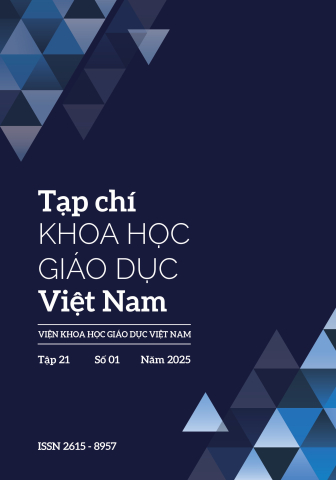[1] Ahmadi, S. M. (2016). The importance of listening comprehension in language learning. International Journal of Research in English Education, 1(1), 7-10.
[2] Albirini, A. (2006). Teachers’ attitudes toward information and communication technologies: The case of Syrian EFL teachers. Computers & Education, 47(2006), 373–398.
[3] Anderson, J. (2010). ICT transforming education: A regional guide. Bangkok: UNESCO.
[4] Berce, J., Lanfranco, S., & Vehovar, V. (2008). E-governance: Information and communication technology, knowledge management, and learning organization culture. Informatica, 32(2).
[5] Collis, B., & Moonen, J. (2001). Flexible learning in a digital world. Experiences and expectations. London: Kogan Page.
[6] Darasawang, P., & Reinders, H. (2010). Encouraging autonomy with an online language support system. Computer-Assisted Language Learning - Electronic Journal, 11(2).
[7] Davis, F. D. (1989). Perceived usefulness, perceived ease of use, and user acceptance of information technology. MIS Quarterly, 13(3), 319-339.
[8] Davies, G., & Hewer, S. (2009). Introduction to new technologies and how they can contribute to language learning and teaching. In G. Davies (Ed.), Information and Communications Technology for Language Teachers. Thames Valley University.
[9] Devi, M. R. (2022). The importance of speaking and listening abilities for EFL students. International Journal of Advanced Multidisciplinary Scientific Research (IJAMSR), 5(7), 1-5.
[10] Drent, M., & Meelissen, M. (2008). Which factors obstruct or stimulate teacher educators from Using ICT innovatively? Computers & Education, 51(1), 187 199.
[11] Duong, T. M., Tran, T. T. H., & Tran, T. Q. (2019). Eleventh graders’ actual use of English listening learning strategies at Duong Van Duong high school. VNU Journal of Foreign Studies, 35(1), 114 130.
[12] Duressa, B. T., Woldemariam, G. S., & Wakjira, A. T. (2022). The effects of listening strategies instruction on EFL students’ listening achievements and motivation. East African Journal of Social Sciences and Humanities, 7(2), 63-82.
[13] Finger, G., Russell, G., Jamieson-Proctor, R., & Russell, N. (2007). Transforming Learning with ICT: Making IT Happen. Frenchs Forest, N. S. W: Pearson Education Australia.
[14] Gardner, R. C. (1885). Social Psychology and Second Language Learning: The Role of Attitudes and Motivation. London: Edward Arnold.
[15] Gillespie, H. (2006). Unlocking learning and teaching with ICT: Identifying and overcoming barriers. London: David Fulton.
[16] Hale, G. A., & Lewis, M. (Eds.). (1979). Attention and Cognitive Development. New York: Plenum Press.
[17] Ipiña, L. N. (2012). The Use of Wikis in a CLIL-POL Context as Tools for Collaborative Writing. Impact of Attitudes. (Unpublished doctoral thesis). Eskoriatza: Mondragon University.
[18] Jung, S. H. (2006). The use of ICT in learning English as an international language. (Unpublished doctoral thesis). University of Maryland, College Park, the USA.
[19] Kleiman, G. M. (2004). Myths and realities about technology in K-12 schools: Five years later. Contemporary Issues in Technology and Teacher Education, 4(2), 248-253.
[20] Klimova, B. F., & Poulova, P. (2014). ICT as a motivational tool in the learning of foreign languages.
[21] Kopinska, M. (2013). New technologies in foreign language classroom: The role of attitudes. The 6th edition of the ICT for Language Learning Conference.
[22] Krashen, S. (1985). The input hypothesis: Issues and implications. Harlow: Longman
[23] Kubiatko, M. (2010). Czech university learner’s attitudes towards ICT used in science education. Journal of Technology and Information Education, 2(3), 20-25.
[24] Kullberg, T. (2011). Swedish teachers’ and learners’ views on the use of ICT in the English classroom. [Unpublished BA thesis]. Linnaeus University, Spain.
[25] Kuo, L. L. (2009). The effects of YouTube listening/viewing activities on Taiwanese EFL learners’ listening comprehension. (Unpublished doctoral thesis). La Sierra University, the USA.
[26] Landers, R. N. (2015). Developing a theory of gamified learning: Linking serious games and gamification of learning. Stimulation & Gaming, 45(6), 752-768.
[27] Liu, J. H. (2009). A survey of EFL learners’ attitudes towards information and communication technologies. English Language Teaching Journal, 2(4), 101-106
[28] Loveless, A., DeVoogd, G. L., & Bohlin, R. M. (2013). Something old, something new… Is pedagogy affected by ICT? In V. Ellis & A. Loveless (Eds.), ICT, pedagogy and the curriculum: Subject to change (pp. 63-83). New York, NY: Routledge.
[29] Meleisea, E. (2007). The UNESCO ICT in education programme. Bangkok, Thailand: United Nations Educational, Scientific and Cultural Organization.
[30] Morley, J. (1991). Listening comprehension in second/ foreign language instruction. In M. Celce-Murcia (Ed.), Teaching English as a second or foreign language (2nd ed.) (pp. 81-106). Boston: Heinle and Heinle.
[31] Nevisi, R. B, & Modarresi, M. H. (2023). The effect of audiovisual input on EFL learners’ receptive and productive vocabulary knowledge of concrete and abstract words. Teaching English Language, 17(2), 325-360.
[32] Nguyen, H. C. (2007). Teaching and learning of foreign languages in Vietnam: The current situation and some solutions. Social Sciences Information Review, 1(1), 43–53.
[33] Nguyen, N. H. T., & Tri, D. H. (2014). An exploratory study of ICT use in English language learning among EFL university learners. Teaching English with Technology, (4), 32-46.
[34] Nguyen, N., Williams, J., & Nguyen, T. (2012). The use of ICT in teaching physics: Technology and pedagogy. Asia-Pacific Forum on Science Teaching and Learning, 13(2), 1-19.
[35] Nguyen, Q. N., & Thai, D. C. (2018). Listening comprehension: First-year English-major students’ perceptions and problems. Can Tho University Journal of Science, 54(2), 75- 83.
[36] Nugroho, A., Zamzami, M. R. A., & Ukhrowiyah, N. F. (2020). Language input, learning environment, and motivation of a successful EFL learner. Journal on English as a Foreign Language (JEFL), 10(1), 46-69
[37] Olatoye, R. (2011). Levels of participation in ICT training programs, computer anxiety, and ICT utilization among selected professionals. International Journal of Education and Development using ICT, 7(2), 15-26
[38] Oxford, R. L. (1990). Language learning strategies and beyond: A look at strategies in the context of styles. Shifting the instructional focus to the learner, 35, 55.
[39] Pusack, J. P., & Otto, S. (1997). Taking control of multimedia. In M. D. Bush & R. M. Terry (Eds.), Technology-enhanced language learning (pp. 1-46). Lincolnwood, IL: National Textbook Company.
[40] Rost, M. (1994). Online summaries as representations of lecture understanding. In J. Flowerdew (Ed.), Academic listening: Research perspectives (pp. 93-128). Cambridge University Press.
[41] Saunders, G., & Pincas, A. (2004). Learner Attitudes towards Information Technologies in Teaching and Learning in the UK.
[42] Secules, T., Herron, C., & Tomasello, M. (1992). The effect of video context on foreign language learning. The Modern Language Journal, 76(4), 480–490. https://doi.org/10.1111/j.1540-4781.1992. tb05396.x
[43] Siegel, J. (2014). Problematising L2 listening pedagogy: The potential of process-based listening strategy instruction in the L2 classroom (Unpublished doctoral thesis). Birmingham: Aston University
[44] Siragusa, L., & Dixon, K. (2009). Theory of planned behavior: Higher education students’ attitudes towards ICT-based learning interactions. In Same places, different spaces. Proceedings ascilite Auckland 2009. http://www.ascilite.org.au/conferences/ auckland09/procs/siragusa.pdf
[45] Thorne, S. L., & Payne, J. S. (2005). Evolutionary trajectories, Internet-mediated expression, and language education. CALICO Journal, 22(3), 371 397.
[46] Vannestål, M. E. (2009). Lära engelska på internet. Lund: Studentlitteratur.
[47] Zhao, Y. (2003). Recent developments in technology and language learning: A literature review and meta-analysis. CALICO Journal, 21(1), 7-27.


